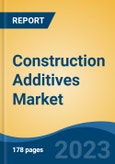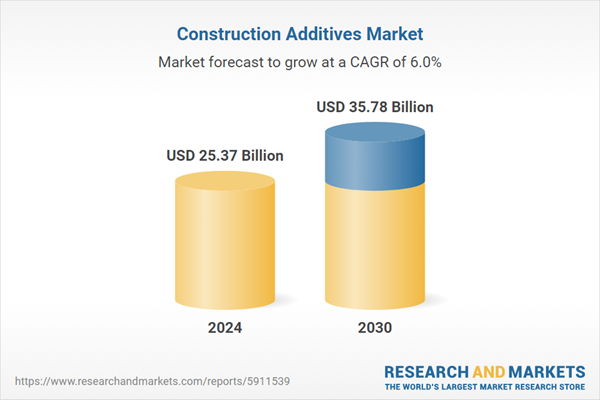Speak directly to the analyst to clarify any post sales queries you may have.
10% Free customizationThis report comes with 10% free customization, enabling you to add data that meets your specific business needs.
This surge in construction projects has significantly increased the need for high-performance building materials, positioning construction additives as essential components that enhance strength, durability, and chemical resistance in concrete and other construction materials. Technological advancements have further accelerated the adoption of construction additives. With the shift toward innovative and efficient construction method, such as 3D concrete printing, prefabricated buildings, and high-rise construction - there is a rising demand for additives that improve workability, setting time, and structural integrity. These additives help construction professionals meet project requirements while optimizing costs and ensuring quality, especially in large-scale or complex builds.
Key Market Drivers
Growth in Construction Industry
The world's rapidly growing population is leading to a significant increase in construction activities across the globe. From large-scale residential housing projects to massive infrastructural developments, the construction industry is experiencing an unprecedented boom. This exponential growth directly impacts the demand for construction additives, which are integral to enhancing the durability, strength, and chemical resistance of various construction materials.In response to the mounting environmental concerns, the construction industry is undergoing a profound shift towards more sustainable and eco-friendly practices. This transformative change includes the adoption of construction additives that not only reduce carbon emissions but also enhance energy efficiency. The growing focus on sustainability is driving extensive research and development activities in the construction additives sector, leading to the emergence of innovative and environmentally friendly additives. Global construction output is projected to grow significantly, rising from USD 9.7 trillion in 2022 to USD 13.9 trillion by 2037. This growth is primarily driven by the robust expansion of major construction markets, including China, the United States, and India, which continue to invest heavily in infrastructure development and urbanization.
The proactive initiatives, coupled with substantial investments in infrastructure development, are further fueling the growth of the construction industry and, consequently, the construction additives market. The remarkable growth of the construction industry plays a pivotal role in driving the global construction additives market. Whether it's the population-driven construction boom, rapid technological advancements, heightened emphasis on sustainability, or the proactive measures taken by governments, all these factors underline the construction industry's exponential growth as a key driver of the ever-increasing demand for construction additives. As the construction industry continues to evolve and expand, the construction additives market is poised to thrive alongside it, catering to the evolving needs of the industry and contributing to sustainable and resilient construction practices.
Key Market Challenges
Volatility in Prices of Raw Materials
The construction additives sector, like many others, heavily relies on raw materials sourced from various suppliers. These raw materials, such as chemicals and minerals, play a crucial role in the production of construction additives. However, the price fluctuations of these materials can significantly impact the overall cost of production for construction additives. When the costs of raw materials rise, manufacturers may face the difficult decision of either absorbing the increased expenses or passing them onto consumers. This can lead to increased market prices for construction additives, potentially affecting the affordability and accessibility of these products.Price volatility not only affects the cost but also disrupts the reliability of supplier projections. The uncertainty surrounding raw material prices makes it challenging for companies to accurately forecast their costs, impacting their strategic planning and budgeting processes. This can create additional hurdles for companies in the construction additives sector, as they need to navigate through the ever-changing landscape of material costs.
Furthermore, the high costs of raw materials can potentially slow down the growth of the construction additives market. As manufacturers face increased expenses, they may have limited resources to invest in research and development, innovation, and expanding their product offerings. This can hinder the industry's ability to introduce new and improved construction additives to meet the evolving needs of customers.
Key Market Trends
Growing Demand of Fiber-Reinforced Concrete
The global construction additives market is experiencing a significant trend - the surging demand for Fiber-Reinforced Concrete (FRC). This increased demand can be attributed to several key factors. Firstly, there is a growing need for eco-friendly and sustainable materials in the building and construction industry. FRC provides a viable solution as it combines concrete or mortar with fibrous materials, resulting in a more environmentally conscious choice. The rising demand for high-performance construction materials has also contributed to the popularity of FRC. With its enhanced strength and durability, FRC offers a reliable and long-lasting solution for various construction projects. This is particularly evident in the Asia Pacific region, where FRC has gained significant traction in recent years.FRC consists of fibers made from a variety of materials, including steel, glass, synthetic, or natural materials. These fibers are evenly distributed and randomly oriented within the concrete, providing added strength and resilience against wear and tear. The incorporation of FRC not only improves the performance of concrete but also enhances its overall durability, making it an ideal choice for a wide range of applications.
Key Market Players
- Dow Chemical Company
- BASF SE
- MAPEI SpA
- Sika AG
- W.R. Grace and Company
- RPM International Inc.
- Thermax Limited
- Hycrete, Inc.
- Concrete Additives and Chemicals Private Limited
- Evonik Industries AG
Report Scope:
In this report, the Global Construction Additives Market has been segmented into the following categories, in addition to the industry trends which have also been detailed below:Construction Additives Market, By Type:
- Mineral Additives
- Chemical Additives
- Fibre Additives
Construction Additives Market, By End User:
- Commercial
- Residential
- Infrastructural
Construction Additives Market, By Region:
- North America
- United States
- Canada
- Mexico
- Europe
- France
- United Kingdom
- Italy
- Germany
- Spain
- Asia-Pacific
- China
- India
- Japan
- Australia
- South Korea
- South America
- Brazil
- Argentina
- Colombia
- Middle East & Africa
- South Africa
- Saudi Arabia
- UAE
- Egypt
Competitive Landscape
Company Profiles: Detailed analysis of the major companies present in the Global Construction Additives Market.Available Customizations:
With the given market data, the publisher offers customizations according to a company's specific needs. The following customization options are available for the report.Company Information
- Detailed analysis and profiling of additional market players (up to five).
This product will be delivered within 1-3 business days.
Table of Contents
Companies Mentioned
- Dow Chemical Company
- BASF SE
- MAPEI SpA
- Sika AG
- W.R. Grace and Company
- RPM International Inc.
- Thermax Limited
- Hycrete, Inc.
- Concrete Additives and Chemicals Private Limited
- Evonik Industries AG
Table Information
| Report Attribute | Details |
|---|---|
| No. of Pages | 185 |
| Published | July 2025 |
| Forecast Period | 2024 - 2030 |
| Estimated Market Value ( USD | $ 25.37 Billion |
| Forecasted Market Value ( USD | $ 35.78 Billion |
| Compound Annual Growth Rate | 5.9% |
| Regions Covered | Global |
| No. of Companies Mentioned | 10 |









